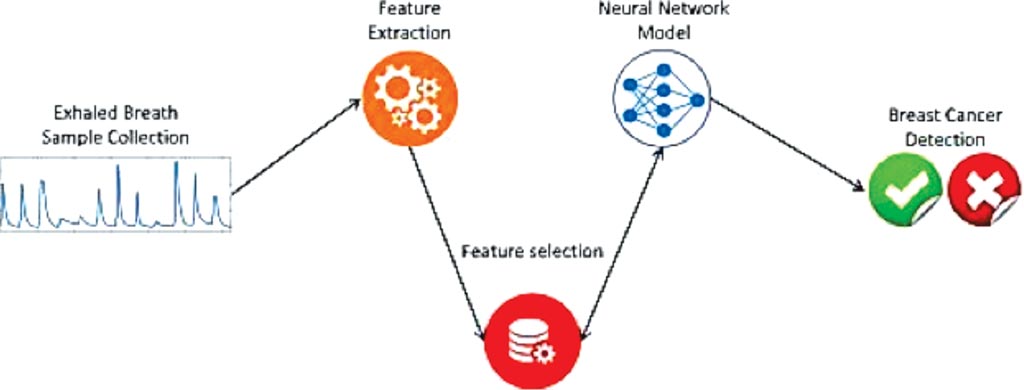Breath and Urine Tests Detect Early Breast Cancer
By LabMedica International staff writers
Posted on 08 May 2018
Breast cancer is the most commonly diagnosed malignancy among females and the leading cause of death around the world. In 2016, breast cancer accounted for 29% of all new cancers identified in the USA and was responsible for 14% all cancer-related deaths.Posted on 08 May 2018
Current diagnostic imaging detection for smaller tumors has significant drawbacks: dual-energy digital mammography, while effective, increases radiation exposure, and magnetic resonance imaging (MRI) is expensive. Biopsies and serum biomarker identification processes are invasive, equipment-intensive and require significant expertise.

Image: A diagram of breast cancer detection using artificial neural network (Photo courtesy of Ben-Gurion University).
Scientists at the Ben-Gurion University of the Negev (Beersheba, Israel) collected exhaled breath samples from 48 breast cancer (BC) patients and 45 healthy women that served as a control group. Urine samples were collected from 37 patients who were diagnosed with BC based on physical or mammography tests prior to any surgery, and from 36 healthy women. Two commercial electronic noses (ENs) were used for the exhaled breath analysis. Urine samples were analyzed using Gas-Chromatography Mass-Spectrometry (GC-MS).
Statistical analysis of results was based on an artificial neural network (ANN) obtained following feature extraction and feature selection processes. The model obtained allows classification of breast cancer patients with an accuracy of 95.2% ± 7.7% using data of one EN, and an accuracy of 85% for the other EN and for urine samples.
The authors concluded that the developed statistical analysis method enables accurate classification of patients as healthy or with BC based on simple non-invasive exhaled breath and a urine sample analysis. This study demonstrates that available commercial ENs can be used, provided that the data analysis is carried out using an appropriate method.
Yehuda Zeiri, PhD, a professor of Biomedical Engineering and senior author of the study said, “Our new approach utilizing urine and exhaled breath samples, analyzed with inexpensive, commercially available processes, is non-invasive, accessible and may be easily implemented in a variety of settings.” The study was published on May 1, 2018, in the journal Computers in Biology and Medicine.
Related Links:
Ben-Gurion University of the Negev














